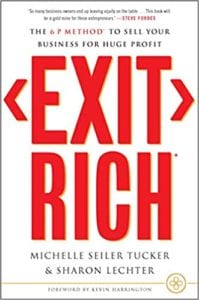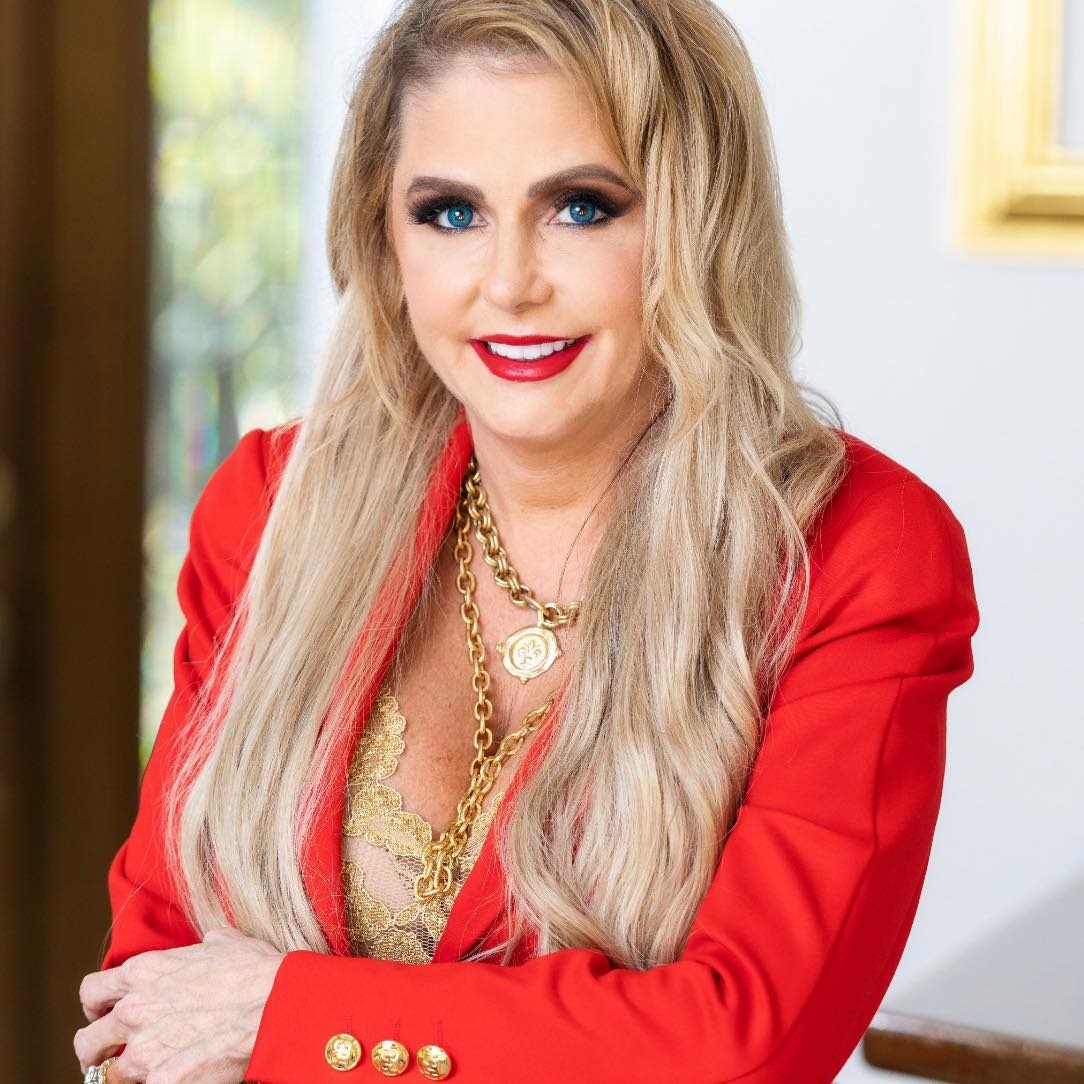Michelle Seiler Tucker discusses how you can set up your business to sell and why you should think of selling even when you don’t need to.
One of the biggest problems for most business owners is not preparing to sell. Even if they aren’t thinking of selling, they should at least evaluate their company. Just like a car, you should pump fuel into your business, take it to the mechanic, and get tune-ups. You want your business to be in its prime so that when push comes to shove, and you have to sell, it will sell fast and earn you a nice profit.
Join your host, Menny Hoffman, and his guest, Michelle Seiler Tucker, as they talk about selling your business. Michelle is the Founder and President of Seiler Tucker Incorporated and the author of Exit Rich. She is also a Mergers & Acquisitions Master Intermediary and a Certified Senior Business Analyst. Listen in to learn why you need to prepare to sell your company and the 6 Ps of selling your business.
Listen to the podcast here:
Download the audio file here.
How to Get the Best Buyer for Your Business—with Michelle Seiler Tucker
Our guest is Michelle Seiler Tucker. She is the Founder and CEO of Seiler Tucker Incorporated and also owns many other businesses in several different industries. As a veteran in the merger and acquisition industry, she is regarded as the leading authority on buying, selling, fixing and growing businesses. Michelle and her team have sold over 1,000 businesses in almost every vertical and have a remarkable track record of success. In our interview, Michelle and I discussed why it’s important for every business owner to serve the company right if they want to sell eventually. We also discussed that for every business, there are different types of buyers.
We went through the five types of buyers and how you need to know who potentially your best buyer is for your type of business. We also discussed the importance of learning. The same way you do a yearly checkup with the doctor, it’s important to understand yearly if the valuation of your company goes up or down and adjust accordingly. Finally, we discussed her new book Exit Rich. She went through a couple of those different chapters on how to set up your company right so you know you’re on the right track. Without further ado, here is my interview.
—
Michelle, thank you so much for joining me on the show.
Thank you. It’s a pleasure to be here.
For our readers, as we always do at the beginning of the show, we try to give a little bit of background on our guests. We know that our topic will be something that our readers will enjoy and learn more about the concept of preparing for selling your business even if you’re not planning to sell at least at the moment. Tell us a little bit about your background.
I’m a Merger and Acquisitions Master Intermediary, Senior Business Analyst and several other acronyms behind my name. I’ve been in this industry for over twenty years. I’ve personally sold over 500 companies. My firm altogether, sold over 1,000. We specialize in buying, selling, fixing and growing companies. I buy businesses for them. I partner with business owners, investing my time, resources, energy, efforts, capital and wish to help them build their business to sell for their desired price tags. Our core competency is buying, selling, fixing and growing companies. At any given time, I own 5 to 10 different businesses that I’m building to sell.
You’re not just a broker, you sometimes get involved in the actual business.
I’m not a broker at all. Brokers sell pizzerias. We sell businesses that are $2 million and up with an EBITDA of $1 million and up. I’m a Merger and Acquisitions Master Intermediary.

Let’s start with the premise. A lot of people, when they hear merger and acquisition, they think, “I’m a small company. I’m not even thinking of selling at the moment.” Why should people read this episode as we’re going to go deeper into the content?
If people want to be successful and build a business that is sellable and not end up in the 80% of businesses that will never sell, then they should read this content.
That’s exactly what we need to hear. Our company is over twenty years now and I remember when we started the agency, somebody gave me the book Built to Sell. I said, “I’m not planning to sell. I’m not a software company or something in Silicon Valley that I want to sell.” People said, “No, you got to read this book because it’s about how to set up your company properly even if you’re not planning to sell. At least, it’s not everything about yourself. You’re building a company that has assets and value.”
Built to Sell is antiquated. That book was written years ago. Our book that’s just coming out. It is called Exit Rich. It’s all about building a sustainable and scalable asset so when you are ready to sell, you have a sellable business. Steve Forbes says that 8 out of 10 businesses will never sell. That’s 80%. Steve Forbes endorsed Exit Rich. It’s a goldmine for entrepreneurs, as entrepreneurs leave way too much money on the table when they go to sell their business.
Let’s dive in deeper a little bit on this topic. What are the fundamentals? We could speak about some of the parts of the book or in general and terminology as you teach and speak about on the topic of exiting rich, what are the fundamentals of a business owner? I want to split the question into two parts. One is when somebody is setting up a new company, which is much easier. I then want to dive into somebody that has already a business, maybe gone for a couple of years, reading this and saying, “What could I do now in order to get myself into that mindset?”
It doesn’t matter if you’re starting now or if you’ve been in the business for 2 to 3 years. The fundamentals are the same. First and foremost, let’s start with the GPS exit. The biggest mistake the business owners make is they don’t think about selling until a catastrophic event has occurred, whether that’s internal or external. Internal being health issues, partners, disputes, divorce and death. External being this pandemic that we’re in. The worst time to sell your business is when you’re in the middle of a catastrophe. The best time to sell your business is when your business is doing well and in its prime. The problem is business owners don’t think about their exit. They never plan their exit. We walk our owners through what we call the GPS Exit Model.
Number one, when you want to drive somewhere, what do you do? You pull out your phone. You go to Google Maps. What do you plugin? Your destination. If you don’t plug in your destination, what are you going to do? You’d be driving around and go nowhere. That’s what business owners do. Business owners don’t have a destination. They don’t plan to fail, they fail to plan. They have no destination in mind. They have no end game, no desired sell price. We work with our clients to determine their destination. What is their endgame? As Stephen Covey says, “Start with the end in mind.” What do you want to sell your business for? Pick a number. Let’s say you want to sell your business for $20 million. Now we have a number. What is the GPS Exit Model need to know next? It needs to know where you’re starting from. What is your current location? What is your current evaluation? Most business owners have never gotten a business valuation. They have no idea what their business is worth.
I met with a business owner the other day. They have been in business for 40 years and never had his business valued. We go to the doctor once a year to make sure our heart is still ticking and we’re still kicking. We take our car to the mechanic to make sure we get an annual tune-up, but our most valuable asset, which is our business, we don’t get an annual valuation checkup to see what our business is worth. That is financial suicide. You should know what your business is worth every year because there are events that increase valuation and are events that decrease valuation. Every year, you need to know what your business is worth. Let’s say you want to sell for $20 million and you’re currently worth $5 million. The next step in a GPS Exit Model is to know what your timeframe is. How many years? Let’s say you want to do this in ten years. You want to sell for $20 million, you’re worth $5 million and you want to do this in ten years.
What’s the very next step? The very next step is to identify who your buyers are going to be? Notice I said buyers, not buyer. A lot of business owners make the mistake of saying, “I’m going to sell to this buyer.” I have clients that call me all the time and say, “Michelle, I need you to represent me with this one buyer.” I always tell them no, because there’s probably about a 90% chance that that buyer will never close on the sale of your business. Something’s going to happen during due diligence and your deal is going to fall apart, then you have no backup buyers. We never want to put all our eggs in one buyer’s basket. Plus, how can you maximize value? You can never maximize value if you don’t have competition. You don’t create competition if you have one buyer. There are five different types of buyers and most business owners don’t understand this. Ninety percent of buyers are first-time buyers. They don’t buy $20 million companies so you can rule them out.
[bctt tweet=”Learn how to sell your company even if you are not planning to sell.” username=””]
The second type of buyers is turnaround specialists. They don’t buy multimillion-dollar companies. They buy distressed assets so you can rule them out. The third type of buyer are PEGs, Private Equity Groups. There are thousands of thousands of PEGs. We work with about 3,000 of them. Private equity buyers buy based on platform and add-on. A platform is let’s say they want to get in the food manufacturing industry and they’re not currently in food manufacturing. They won’t even consider the business unless it has at least $3 million in EBITDA. That is the minimum requirement of EBITDA, Earnings Before Interest, Taxes, Depreciation and Amortization. Let’s say that they are already in food manufacturing and are looking for an add-on. They found a seasoning company but the seasoning company has $500,000 in EBITDA. They’ll consider companies under $1 million in EBITDA for add-ons. That’s Private Equity Groups.
The fourth type of buyer is strategic/competitors. They typically will pay the highest multiple because they’re paying for synergies. Their buying synergies is going to help catapult their current business to the next level, rather that’s contracts, patents, trademarks, etc. They also take advantage of economies at scale. They also look at the current infrastructure to see what overhead that they can cut from the company they’re looking to acquire in order to increase EBITDA from day one of closing.
The fifth type of buyer is your sophisticated entrepreneur that’s industry agnostic. They just chase cashflow. They chase EBITDA. Those are your five types of buyers. You have to reverse engineer your plan and ask yourself, “These five types of buyers, what are they looking for? What are the revenues need to be? Three of these buyers are going to be right for me. I want to sell for $20 million. Where do revenues need to be? Where are the COGS need to be? Most importantly, what is the EBITDA need to be?”
The EBITDA needs to be around $3 million to $4 million depending upon your synergies. You then have to ask yourself, “If I’m going to build a business to meet the specific criteria of these three types of buyers, what does that look like? What synergies are they looking to buy? What are they willing to pay top dollar for? What are your negotiables? What are your non-negotiables?” You build to meet their specific criteria. It’s like when a company starts a business, they say, “I have a widget. Here’s my widget. Here’s my ideal target market.” They identify who their ideal target market is. All the marketing is built to attract their ideal target market. It’s the same thing with building your business to sell.
Meaning to say, it’s outside of knowing that I want to sell, it’s also knowing the potential buyers, as you mentioned. I have a question. Is this a preference? Each business would be different. This is where a firm like an M&A firm would come into play. How does a typical business owner, a first-time business owner running a company 10, 12 years and looking to exit know who his potential buyers or where he can maximize his exit?
The owner is not going to know where the buyers are. That’s what M&A experts know. You should align yourself with the mergers and acquisitions expert and ask them, “Who are the best buyers for my business? What are those buyers looking for? Where do my numbers have to be for me to get a $20 million payoff?” You need to align yourself with an M&A expert.
Let’s dive into the day-to-day hustle of a business owner. Maybe they have identified that or at least they’re trying to build themselves up and set themselves up for potentially exiting rich. What are the key characteristics of any of those buyers? Obviously, some of the buyers will be different. What must the business have as far as the setup of the company where business owners could say, “In order to prepare myself, I need to do this 1, 2, 3, 4, 5 steps in the business on a regular basis?“
This is what we call the 6 Ps. All businesses should run on all six cylinders, all 6 Ps. We talked about the 6 Ps in my book Exit Rich. First and foremost is People. One of the biggest reasons that businesses don’t sell is because the business is 1,000% dependent upon the owner. If you take that owner out of the business, there is no business. A lot of business owners have created a glorified job. The ones you go and to work at every day versus a business that actually works for them. You don’t build a business, you build people and people build the business. Entrepreneurs have to focus on their strengths and hire their weaknesses. You must put the right people in the right seats and ask the who question. Who opens the door? Who handles customer service, marketing, legal, quality control, manufacturing, logistics and environmental? The clue here is that you should never be next to who because you want the business to run without you. Plus, you need a layer of management. Business owners should be working on their business, not in it. You need a layer of management, COO, CFO. That’s the people component.

The next is Product. What will make a business sellable or non-sellable? It’s the product. You have to ask yourself, “Is my product, my industry, my service on the way up or on the way out? Is it thriving or dying? Do I have an Amazon or do I have a Blockbuster? When I wrote my very first book, Sell Your Business for More Than It’s Worth in 2013, I did the research and learn that 95% of all startups will fail within the first 1 to 5 years. We all know that. That’s common sense. However, what you all don’t know is when I wrote my third book, Exit Rich and did the exact same research, I learned that the business landscape has flipped flopped. It changed dramatically. Now it’s only 30% of startups will go out of business between those 1 to 5 years. However, out of 27.6 million companies, those businesses that have been in business for ten years or longer, 70% of those companies will go out of business.
When you did the first book, the data was what?
The data was 95% of most startups will fail.
Now, when you did the research, you found that the first few years?
In 1 to 5 years, only 30% will go out of business. Startups are now being able to sustain themselves. Whereas the businesses that have been in business for over ten years are going out of business. That was out of 27.6 million companies. Those businesses have been in business for ten years or longer, 70% of them are at risk of going out of business. You heard about the public companies all the time. Toys “R” Us was in business for 75 years and goes out of business.
What are the reasons for that shift? Is it because there’s more funding available for startups?
That is not the reason. Let me finish telling you and then I’ll tell you the reason. You hear the media talks about the big public company all the time like Toys “R” Us was in business for 75 years and goes out of business. Kmart, Stein Mart, Pier 1, GNC is closing down on 100 locations. The Disney stores are going out of business. Godiva was closing down 1,500 locations. The media talks about the big public companies. You never hear the media talk about private companies because that’s not big news. They don’t care about private companies. All the private companies on every street corner in every town and every state across our great nation, these business owners are exiting poor. They’re selling for pennies on the dollar, closing their businesses or even worse, filing bankruptcy.
What is the reason for this? Number one is the lack of AIM. Business owners stop doing what I call AIM, you should Always Innovate and Market. Toys “R” Us did nothing new in 75 years. Blockbuster saw the writing on the wall with Netflix. They sat back. They had an opportunity to purchase Netflix. They did nothing to innovate. They ended up out of business. Business owners get complacent. They are married to the concept that they started and they don’t want to change. You are either growing or dying. There is no in-between. These businesses are going out of business because of a lack of innovation and lack of marketing. You own a marketing company.
That brings me to the product. You always have to innovate products. When Steve Jobs came back to Apple, what does Steve Jobs do? Innovate. You always have to innovate. You always have to ask yourself three questions. Amazon did this is back in the ’90s. Ask yourself, what business are we in? They said, “We’re in a bookselling business, we fulfill book orders.” The second question is, what do we do well better than everybody else? What’s our USP? Amazon said, “We do fulfillment better than everyone else.” The third obvious question is, what business should we be in? Amazon said, “We should be in a fulfillment business, fulfilling products for everyone, all around the world.” Those three transformational questions transformed Amazon from a small bookseller to the multi-billion dollar worldwide conglomerate that they are now. You have to pivot.
[bctt tweet=”When selling your company, never put all of your eggs in one buyer’s basket.” username=””]
The point that you’re mentioning is that you got to know where the market is going.
Exactly. Whoever makes the easiest for the consumer to purchase products and services is a company that’s going to win. Amazon is winning because you can practically buy anything and have it delivered to your house within two days. Amazon pays attention to what the customer wants. Steve Jobs didn’t pay attention to what the consumer wants. He created what the consumer is going to want and need in the future that we didn’t even know we needed and wanted. I remember the first time I saw an iPad. I’m like, “That’s the most stupid thing I’ve ever seen. Why would anybody get an iPad when you can have a laptop?” Now, I have twelve iPads in my office and guess what? You go to a car dealership and they all have iPads. You go to your medical doctor and they all have iPads. Steve Jobs was pre-internet. He figured out what people wanted and needed way before we ever knew what we wanted and needed. He created the demand.
Let’s talk about that and expand on that, which is what you’re seeing now in the market based on your expertise. There’s a lot of money floating into mergers and acquisitions in different markets. You also see a lot of VC money coming into startups in Silicon Valley and more on the technology side. What has that done to the industry as a whole?
The industry right now is thriving. There are more money-changing hands and more M&A transactions than ever before. There are more buyers for good businesses than there are good businesses to buy. When you get your EBITDA over $1 million, $2 million, $3 million, that’s when we can bring hundreds and hundreds of buyers to one transaction creating a bidding war.
Let’s go into the valuation of a company. What have you seen or what are you seeing trending in the market on different types of business? We know the difference between the service providers. There is product manufacturing. There are also a lot of companies now in software, which has recurring revenue. What have you seen? Every deal has its own uniqueness. Have you seen any shifts in the valuation of companies?
Not really shift, but every deal has its own. Here’s the bottom line. For businesses that are under $1 million in EBITDA, they typically will try for anywhere from 1 to 3, 3.5, maybe 4 if they have a bunch of synergies times EBITDA. If you’re a SaaS company, you’re going to try for multiple revenues. That’s the only industry to trade for multiple revenues. As far as over $1 million in EBITDA, that’s when the multiple goes up. Over $1 million in EBITDA, you’re going to trade for five and up depending upon your synergies. We haven’t finished talking about the 6 P’s, but it is what adds the synergies that buyers are willing to pay top dollar for and outbid everyone else on.
What have you seen in the market? What we see a lot is in the Amazon space, private label sellers are being bought by these syndications of companies. They’re buying a bunch of them. They’re valuating companies still with multiples but not straight out of EBITDA. They go based on taking off any expenses that they wouldn’t acquire.
It’s because they already have the infrastructure. They don’t need that infrastructure so they back out all the expenses and then pay a multiple. Valuation is based upon the buyer. A seller comes up with a price that they have in mind. We come up with a price based on our expertise. Valuations are more of an art than a science, but at the end of the day, it’s the buyer who says what the business is worth to them. If a buyer already has the infrastructure and they don’t need the expenses, then they are going to extrapolate those expenses out and give a multiple of that EBITDA.

At which point do you say that a business is picture-perfect for selling? There’s a saying out there, “How much do you want to sell this for?” You say, “It’s not up for sale.” For the right number, everything is for sale. We see this all the time. People are so invested in their business. Something comes up and all of a sudden, they’re looking to sell their business. What is the perfect setup? At which point do you feel that a business is at the peak that if you want to sell, now’s the time?
There are a few things. Number one, a business operates on all 6 cylinders, all 6 Ps. We got through two of them.
Deliberately because I want people to pick up that book.
Even if we go through the 6 Ps, they are still going to pick up the book because the second half of the book is all about evaluations, recasting of financials, packaging, negotiations, due diligence, LOIs and closing. The first half of the book is about the 6 Ps but we’re not giving that much away. It’s about a business that’s number one, picture-perfect with an EBITDA of over $1 million. Number two, a business operating on all 6 Ps. Number three is selling in your prime. Let me explain that. Businesses go through cycles just like humans go through cycles. We have a life cycle. We have a business cycle. It is the same. When we get born, we’re in an incubator. A business idea gets born in the incubator. A business idea gets out of the incubator. I think 5% to 10% of ideas come out of the incubator. We come out of an incubator, then we’re a newborn. What does the newborn need? Everything, 24 hours supervision and lots of money.
We then go from a newborn to a toddler. The toddler needs 24 hours supervision and lots of money. Toddler business needs 24-hour supervision and lots of money. We then go from a toddler to a teenager. Teenagers don’t need 24 hours supervision but they need lots of money. For a teenager to young adult, we explain this in my book too, you don’t need as much supervision and you don’t need as much money. You then get into what I call your prime. Your prime is your adult phase. This is the best of the best. Toys “R” Us in 2015 was worth $11 billion. They were in their prime. They should have sold when they were in their prime. After your prime, after adult, what happens? You go from adult to senior citizen.
Within one year, Toys “R” Us went from $11 billion to filing bankruptcy. In 2016, they filed for bankruptcy. What happens after senior citizen? Death. In 2017, Toys “R” Us dies and closes up 1,500 locations throughout the United States. Businesses go through the exact same cycle as a human does. Toys “R” Us tried to rebirth and they lost. The bottom line is over $1 million in EBITDA, run on all six cylinders and you’re in your prime. That’s picture-perfect.
If you look at small businesses in general, we discussed this as the first P which is people. Most companies start off with the entrepreneur starting their own venture. Slowly but surely, they bring in other people to the venture as they grow. Usually, the business owner is still the best salesperson, the best negotiator, most of the time and does the service or product development. That’s how they started. What is the fine balance of a person being involved in the business but not holding the business hostage if they’re looking to sell eventually?
It’s not just small companies either. That’s a misconception that a lot of people have is that small businesses have issues with people and only small businesses are dependent on the owner. That’s not true at all. I’m selling a $70 million company right now and that company has 300 employees, but it cannot continue without the owner. It would be impossible because the owner has relationships with the clients, especially their major clients. This owner knows all the intricate details. It’s still in his head and not on paper. The bottom line is, owners have to focus on their strengths, and hire their weaknesses, but they have to work on the business and take themselves out of the business. They need to get everything out of their head onto paper. I wish that I could just plug a flash drive in somebody’s head and download it because it would help us dramatically. We have so many businesses that we’re selling that are so tough because all the data is in the owner’s head still.
It’s more than the actual work that they do versus putting everything on paper.
[bctt tweet=”You don’t build a business. You build people, and people build the business.” username=””]
That’s all the IP, intellectual property. We’re selling a fabrication company with two partners. They have been in business for 45 years. They have employees. They simply show, “We can fabricate anything for anybody at any time.” Great but where all those manuals? “It’s in our head.” That doesn’t serve a purpose. I had a nice little lady call me a couple of months ago. Her husband dropped dead of a heart attack and left her with a mountain of debt. She wants to know if I could sell the business. He only has subcontractors. How can I sell the business? Where are your policy and procedure manuals? Where’s all the data? She goes, “It’s in his head.” When he died, the business died. The number one thing an owner has to do is get the IP out of their head into a computer system or onto paper.
Let me get another question on this topic. This is something that I’m not sure if you have a one size fits all type of answer. There are a lot of people that sell and they say, “I want to sell but I want to be involved. I want to stay on board. I want to have something on the upside.” What have you seen in the past? Is this something that’s workable? Somebody who sells a company, then another new company, a new type of management comes in. I’ve seen a very mixed bag on that. Is it even an option of the old business owner staying on board for the long term?
For larger businesses, $10 million, $15 million, $20 million, I would say mid-market, it absolutely is the preference of the buyer. We are seeing almost every single deal be a percentage sell versus 100%. The buyers want the owner to stay on. They want their management team to stay on. They will buy 70%, 80%, 90% of the business. It is a preference of most buyers, especially private equity and strategics. It depends upon the owner but a lot of the owners want to retain some equity. They know that they have to stay on for 2 to 3 years. They’ll stay on with retaining equity, their salary and benefits. It is quite common.
Do those usually work out? Entrepreneurs or business owners have a style of leadership and style of operations. Sometimes you have now a new culture and a new type of operations coming in.
It depends upon the buyer. I’ve seen it work and I’ve seen it not work. I’ve seen both cases. A lot of these buyers are private equity. They’re sophisticated. They’re not going to go in there and ruffle feathers. They know what the business owner has been doing and has been working. Yes, they want to inject capital; they want to grow the business; they want to add people, etc. but they won’t go in there, beat their chests and say, “I’m the boss. You have to listen to me.” They know that the owner got this far and they want to work with the owner to continue to grow the legacy. There are competitors and strategists that the ego gets in the way and that can be difficult. For the most part, I’ve seen it work more than it hasn’t worked.
We mentioned the book entering the episode, Exit Rich. For our readers, who is the book for? Who is the book not for?
The book is for all entrepreneurs. Anyone who owns a business, all entrepreneurs, anyone who wants to start a business or even buying a business—because Exit Rich is not just about selling a business. It’s about building a sellable asset. It’s about building a business that you can sustain and scale so you can sell it at your desired price tag. Who is it not for? My husband read the book and he’s probably biased. He said that it’s even for management teams because it’s all about building a solid foundation that will be sellable one day. Who is it not for? Probably those people who have zero interest in the business.

It’s an important factor because it’s either you are or you’re still not in the mindset that you’re building something bigger than yourself. There are people that are limiting the growth of their own company based on their own growth.
That’s a great point that you just mentioned because I partner with business owners and that’s something that I always say. You will only grow the company as much as you can grow the owner. You will never grow the company beyond what you grow the owner.
Where could people find more about the book, a little bit about yourself and your firm?
Exit Rich was endorsed by Steve Forbes who says it’s a goldmine for entrepreneurs, as most entrepreneurs leave way too much money on the table when they go to sell their business. Sharon Lechter is my co-author who wrote Rich Dad Poor Dad with Robert Kiyosaki. She is a New York Times bestselling author five times, CPA, financial literacy expert, advisor to many different presidents. Kevin Harrington, the original shark on Shark Tank wrote the foreword. You can go to ExitRichBook.com for $24.79, which by the way is less than Amazon. We will email you the digital download immediately so you can start reading Exit Rich. We will ship the hardcover to your doorstep upon launch day to anyone who lives inside the United States for no additional shipping cost.
This is only up until you buy the book before June 22, 2021. We will give you a lifetime membership into the Exit Rich Book Club, whether it’s video training and me doing deep dives in different techniques and strategies that I’ve been teaching over the last twenty years in the trenches. Plus documents to operate your business, documents to sell your business, sample org charts, policy and procedure manuals, employee handbooks, sample letter of intent, purchase agreements, due diligence checklist and closing docs. All the documents you need to operate and sell your business are there for your review and download. This would cost you thousands upon thousands of dollars if you went to your attorney to recreate. Plus, we will give you a 30-day membership to Club CEOs, which is an entrepreneurship mastermind. We will do hot seats and Q&As where we ask those transformational questions and help business owners pivot so they too can build a sustainable, scalable and sellable business.

This is a ton of stuff happening outside of what you already shared with our readers. I encourage our readers, if they do feel that they want to set up a scalable business that is ready for selling in primetime, please connect to Michelle. Let’s close with the four rapid-fire questions. Are you ready?
Yeah. I also want to just give my main website, SeilerTucker.com if anyone wants to contact us.
Number one, a book that changed your life.
A book that changed my life, Think and Grow Rich by Napoleon Hill.
Number two, a piece of advice you got that you never forget.
Things happen for us, not to us.
Number three, anything you wish you could go back and do differently.
Get a mentor much earlier on.
Number four and final question, what’s still on your bucket list to achieve?
Making the New York Times bestsellers list.
We’re praying for you. Thank you so much for joining us. I know your time is valuable. That is why in the name of our readers, we will forever be grateful for sharing some of your time with us.
Thank you.
It’s my pleasure.
Links Mentioned:
- Seiler Tucker Incorporated
- Exit Rich
- Built to Sell
- GPS Exit Model
- 6 Ps
- Sell Your Business for More Than It’s Worth
- Rich Dad Poor Dad
- Think and Grow Rich
- Michelle Seiler Tucker
- Michelle Seiler Tucker – Facebook
- Michelle Seiler Tucker – Instagram
- Michelle Seiler Tucker – Twitter
- Michelle Seiler Tucker – LinkedIn
About Michelle Seiler Tucker
 Michelle Seiler Tucker is the Founder and CEO of Seiler Tucker Incorporated. She holds the M&AMI (Mergers & Acquisitions Master Intermediary) title, as well as Certified Mergers and Acquisitions Professional (CM&AP) and Certified Senior Business Analyst (CSBA). Michelle also owns many other businesses in several different industries. As a 20-year veteran in the M&A industry, she is regarded as the leading authority on buying, selling, fixing, and growing businesses. She and her firm have sold over a thousand businesses in almost every vertical and have a remarkable track record of success
Michelle Seiler Tucker is the Founder and CEO of Seiler Tucker Incorporated. She holds the M&AMI (Mergers & Acquisitions Master Intermediary) title, as well as Certified Mergers and Acquisitions Professional (CM&AP) and Certified Senior Business Analyst (CSBA). Michelle also owns many other businesses in several different industries. As a 20-year veteran in the M&A industry, she is regarded as the leading authority on buying, selling, fixing, and growing businesses. She and her firm have sold over a thousand businesses in almost every vertical and have a remarkable track record of success








